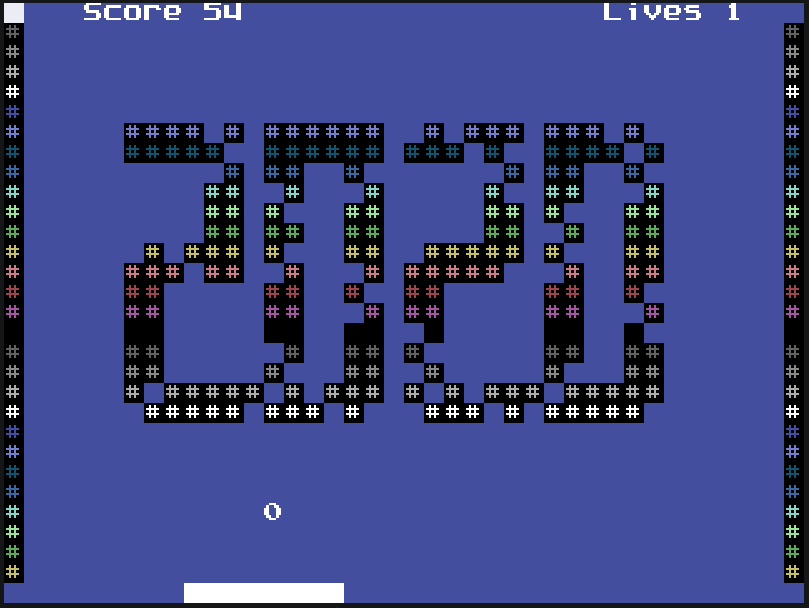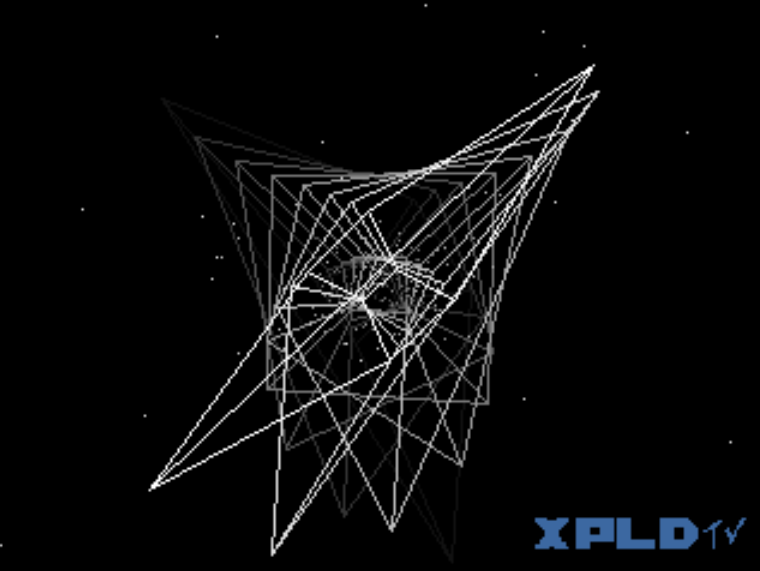XPLD is a fantasy computer created from scratch. The CPU, video chip, disk interface, etc. are all invented.
Of course, XPLD is heavily inspired by home computers of my youth, like the Commodore family of 8 bit PCs, the Commodore Amiga and so on.
XPLD noteworthy components are:
- a 32 bit CPU called Koobra
- a videochip called Koolibri
- a disk interface, called Frisbee
- a soundchip, called Goorilla
This repository contains the XPLD runtime, which compiles with Visual Studio Community 2019. Before running XPLD, you probably have to edit the settings.json file, to point to the right paths for d0:, the system font and the kernal binary.
The gui of XPLD is made with imgui.
XPLD CPU is big endian. It has 16 general purpose registers, 32 bit wide: r0-r15.
Also, you've got:
pc - program counter
sp - stack pointer
f - flags register
NVss DIZC
|||| ||||
|||| |||+- Carry
|||| ||+-- Zero
|||| |+--- Not Used
|||| +---- Not Used
||++------ Not Used
|+-------- Overflow
+--------- Negative
Instruction encoding for the CPU is very simple and unoptimized:
<opcode> [param1, param2, ...]
but we have terabytes of space, so who cares.
Down below you can find a list of the main opcodes. The syntax is similar to Intel assembly (the destination register comes before the source):
| Instruction | Meaning | Opcode |
|---|---|---|
| hlt | Halt CPU | 0x00 |
| nop | No operation | 0x01 |
| ld rx,immediate | Load immediate into register rx | 0x10 |
| ld rx,ry | Load register ry into register rx | 0x11 |
| ld rx,[memory address 32 bit] | load content of memory address into rx, 32 bit | 0x12 |
| ld32 [memory address 32 bit],rx | load content of register rx into memory addres, 32 bit | 0x13 |
| ld8 [memory address 32 bit],rx | load content of register rx into memory address, 8 bit | 0x14 |
| ld32 [memory address 32 bit],immediate | load immediate into memory address, 32 bit | 0x15 |
| ld8 [memory address 32 bit],immediate | load immediate into memory address, 8 bit | 0x16 |
| ld8 [rx],ry | load content of register ry into memory address pointed by rx | 0x17 |
| ld8 rx,[memory address 32 bit] | load content of memory address into rx, 8 bit | 0x18 |
| ld rx, | load address of datalabel into rx | 0x19 |
| ld8 rx,[ry] | load contents of memory address pointed by ry into rx, 8 bit | 0x1a |
| ld32 [rx],ry | load contents of register ry into rx, 32 bit | 0x1b |
| ld8 [rx],immediate | load immediate into address pointed by rx, 8 bit | 0x1c |
| ld32 rx,[ry] | load content of address pointed by ry into rx, 32 bit | 0x1d |
| and rx,immediate | and rx register with immediate value | 0x20 |
| and rx,ry | and rx register with ry | 0x21 |
| add rx,immediate | add immediate to rx | 0x30 |
| add rx,ry | add ry to rx and store result in rx | 0x31 |
| mul rx,immediate | mul register rx by immediate value | 0x32 |
| mul rx,ry | mul register rx by ry | 0x33 |
| sub rx,immediate | sub immediate from register rx | 0x40 |
| sub rx,ry | sub register ry from rx | 0x41 |
| push rx | push rx on stack | 0x50 |
| pop rx | pop into rx from stack | 0x51 |
| cmp rx,immediate | compare rx with immediate and set flags accordingly | 0x60 |
| mod rx,immediate | execute modulo division of rx by immediate | 0x70 |
| jmp label | direct jump to label's address | 0x80 |
| jnz label | jump if not zero flag set | 0x81 |
| jmp <address 32 bit> | direct jump to absolute address | 0x82 |
| jz label | jump if zero flag set | 0x83 |
| jsr subName | jump to subroutine subName | 0x90 |
| rts | return from subroutine | 0x91 |
| jsr | jump to subroutine identified by absolute address | 0x92 |
| shr rx,immediate | shift register rx by immediate bits | 0xa0 |
| shr rx,ry | shift register rx by ry bits | 0xa1 |
| div rx,immediate | divide rx by immediate value | 0xb0 |
XPLD binaries (even the machine's kernal) are created with xpld-assembler, which you can find in this project, along with some examples.
This is XPLD's memory map:
0x00000000-0x0000ffff - kernal, execution starts from 0x0
0x00400000-0x0040ffff - stack
0x00500000-0x005fffff - RAM (1Mb)
0x00600000-0x00610fff - program load zone+data segment
0x10000000-0x100004af - mode 0, videoram, 8 bit chars
0x10001000-0x100014af - mode 0, videoram, 16bg+16fg colours
0x11000000-0x11012bff - mode 2, videoram, 8 bit palettized chars
0x20000000-0x20000fff - koolibri registers
0x20000000 - koolibri status register (8 bit) -> xxxxxxVL (vblank lineblank)
0x20000001 - set videomode register
0x20000002 - set palette entry videomode 2
0x20000003 - set palette value videomode 2 (ABGR)
0x20000100 - sprite 0 attributes: xxxxxxbe (b=0 monochrome, 1 32-bit) (e=enabled 0/1)
0x20000101 - sprite 0 dimx // must be multiple of 8, max 248
0x20000102 - sprite 0 dimy // max 248
0x20000103 - sprite 0 rotation/256*2PI
0x20000104 - sprite 0 posx (4 bytes)
0x20000108 - sprite 0 posy (4 bytes)
0x20000112 - sprite 0 data8 (for monochrome) (8 bits)
0x20000114 - sprite 0 data32 (for 32-bit)
0x20000118 - sprite 0 foreground color (background is transparent)
...
0x20000200 - sprite 1 attributes
...
0x20010000-0x2001ffff - misc registers (keyboard, etc.)
0x20010000 - clock register 32 bit (read only)
0x20010001 - read byte: get key pressed
0x20010002 - read byte: get key pressed modifier (shift, alt, control, etc.)
0x20010010 - mode 0 hw cursor x coordinate
0x20010011 - mode 0 hw cursor y coordinate
0x20020000 - d0: interface - write 8 bit
cmd=1: directory of current disk content
cmd=2: load program to memory - 0x20020001 is a string zero terminated with filename
0x20020001 - d0: interface - write 32 bit
Koolibri has the following videomodes:
- 40x30 rows text mode, commodore style, initial mode on boot. You have 16 colours for the foreground and 16 for the background, from a fixed palette
- 320x240 graphics mode, linear framebuffer, 16M colours
- 320x240, 256 colours with palette from 16M
Koolibri starts in mode 0, entire videoram is cleared with 0x00 char on reset, with 0x54 as fg/bg colours. As you can see from the memory map, Koolibri has Vblank and hblank flags that you can read in code for sync and raster effects.
Koolibri has 16 sprites, with the following attributes:
- sprite attributes: monochrome/32bit, enabled/disabled (visibility)
- dimx (multiple of 8)
- dimy
- rotation degrees
- posx
- posy
- sprite data
The disk interface maps a physical directory of your hard drive with a virtual disk (d0:) for the XPLD computer.
Registers at 0x20020000 and 0x20020001 control the disk interface.
At the moment, register 0x20020000 has 2 commands:
- cmd=1: directory (list current disk content)
- cmd=2: load program to memory - 0x20020001 must point to a zero terminated string with program's filename
Those commands are used internally by the kernal.


